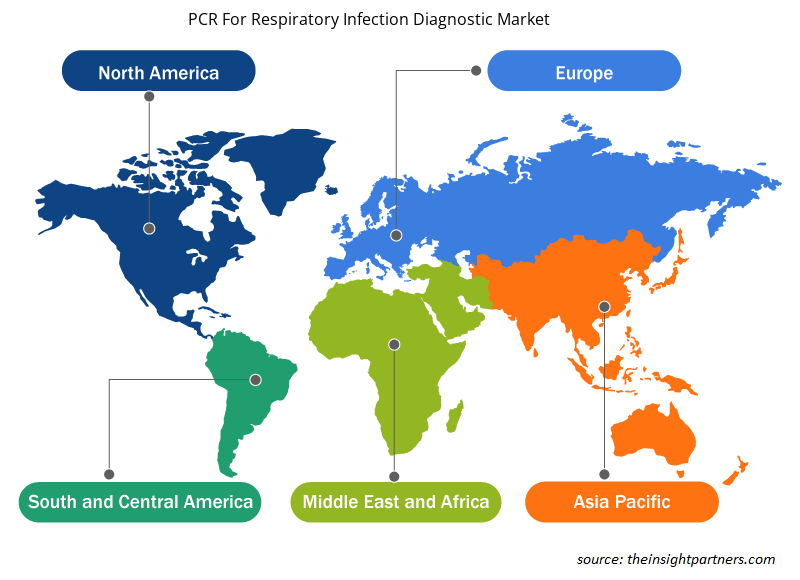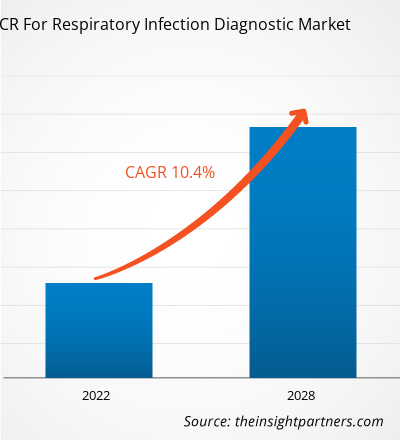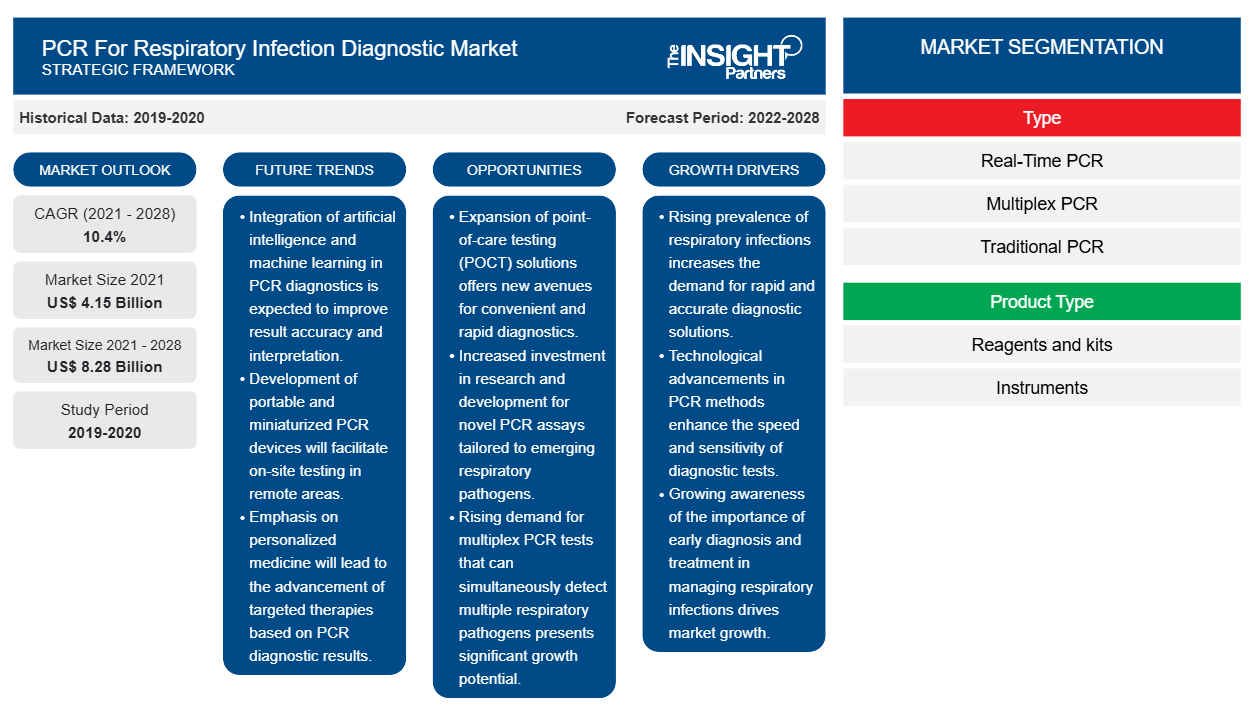到 2028 年,呼吸道感染诊断 PCR 市场价值将从 2021 年的 41.4602 亿美元增至 82.7932 亿美元;预计从 2021 年到 2028 年的复合年增长率为 10.4%。
聚合酶链反应 (PCR) 用于准确的即时诊断,有助于快速识别和确定呼吸道感染的原因。此外,PCR 在住院和门诊环境中广受欢迎,有助于促进近年来市场的增长。
呼吸道感染诊断用 PCR 市场的增长 归因于慢性呼吸道疾病 (CRD) 负担的增加、PCR 检测的不断发展等因素,这些因素正在广泛提高医疗器械的性能。然而,PCR 检测用于各种呼吸道感染诊断,以及用于推导这些诊断的 PCR 技术的发展。替代检测方法的可用性阻碍了市场的增长。
定制此报告以满足您的需求
您可以免费定制任何报告,包括本报告的部分内容、国家级分析、Excel 数据包,以及为初创企业和大学提供优惠和折扣
- 获取此报告的关键市场趋势。这个免费样品将包括数据分析,从市场趋势到估计和预测。
市场洞察
针对各种呼吸道感染诊断的 PCR 检测所采用的市场整合策略
PCR 检测是检测呼吸道传染病(包括 SARS-CoV-2)的金标准。此外,PCR 的不断发展不仅限于 COVID-19 检测。技术的不断发展使研究人员能够以较低的成本开发先进的 PCR 技术并限制其复杂性。随着微流体和下一代测序等技术的不断发展,预计 PCR 检测将增强其分子诊断能力并在未来加强其作用。此外,PCR 检测在疗养院、慢性病护理机构和医院等机构中被广泛用于识别引起呼吸道爆发的流感病毒感染。
此外,急性和慢性呼吸道感染是全球发达国家和发展中国家发病的主要原因之一。据估计,急性呼吸道疾病占全球急性发病率的近 75%。因此,各公司都在提供各种 PCR 试剂盒,用于检测引起呼吸道疾病的病原体的存在。例如,bioMérieux SA 和 altona Diagnostics GmbH 等公司提供各种 PCR 试剂盒,可检测上呼吸道或下呼吸道的急性呼吸道感染。除了急性和慢性呼吸道疾病发病率不断上升外,环境和气候条件、空气污染以及新型细菌、病毒和病原体的发现等其他因素也可能成为未来呼吸道感染诊断 PCR 检测的重要增长机会。
基于类型的洞察
呼吸道感染诊断用 PCR 市场按类型细分为实时 PCR (qPCR)、多重 PCR、传统 PCR、数字 PCR、逆转录酶 (RT-PCR) 等。实时 PCR (qPCR) 细分市场在 2021 年占据了最大的市场份额,预计在预测期内将实现最高的复合年增长率。
基于产品类型的洞察
根据产品类型,呼吸道感染诊断用 PCR 市场细分为试剂和试剂盒、仪器和其他。试剂和试剂盒部分在 2021 年占据了最大的市场份额,预计在预测期内将实现市场最高的复合年增长率。
基于感染类型的见解
根据感染类型,呼吸道感染诊断用 PCR 市场细分为细菌感染、病毒感染以及真菌和其他病原体。2021 年,病毒感染领域占据了最大的市场份额,预计在预测期内将实现最高的复合年增长率。
基于最终用户的洞察
根据最终用户,呼吸道感染诊断用 PCR 市场细分为医院、医生诊所、临床实验室、学术和研究机构、生物技术和制药公司等。2020 年,临床实验室部门占据了最大的市场份额,预计在预测期内将实现市场最高的复合年增长率。
产品发布和审批是企业扩大全球业务和产品组合的常用策略。此外,乳房重建市场参与者专注于合作策略来扩大客户群,这反过来又使他们能够在全球范围内维护自己的品牌。
呼吸道感染 PCR 诊断市场区域洞察
Insight Partners 的分析师已详细解释了整个预测期内影响 PCR 呼吸道感染诊断市场的区域趋势和因素。本节还讨论了北美、欧洲、亚太地区、中东和非洲以及南美和中美洲的 PCR 呼吸道感染诊断市场细分和地理位置。

- 获取呼吸道感染 PCR 诊断市场的区域特定数据
PCR 呼吸道感染诊断市场报告范围
| 报告属性 | 细节 |
|---|---|
| 2021 年市场规模 | 41.5亿美元 |
| 2028 年市场规模 | 82.8亿美元 |
| 全球复合年增长率(2021 - 2028) | 10.4% |
| 史料 | 2019-2020 |
| 预测期 | 2022-2028 |
| 涵盖的领域 | 按类型
|
| 覆盖地区和国家 | 北美
|
| 市场领导者和主要公司简介 |
|
呼吸道感染 PCR 诊断市场参与者密度:了解其对业务动态的影响
呼吸道感染 PCR 诊断市场正在快速增长,这得益于终端用户需求的不断增长,这些需求源于消费者偏好的不断变化、技术进步以及对产品优势的认识不断提高等因素。随着需求的增加,企业正在扩大其产品范围,进行创新以满足消费者的需求,并利用新兴趋势,从而进一步推动市场增长。
市场参与者密度是指在特定市场或行业内运营的企业或公司的分布情况。它表明在给定市场空间中,相对于其规模或总市场价值,有多少竞争对手(市场参与者)存在。
在呼吸道感染 PCR 诊断市场运营的主要公司有:
- 雅培
- F.霍夫曼-罗氏公司
- Hologic 公司
- Seegene 公司
- 澳大利亚诊断公司
免责声明:上面列出的公司没有按照任何特定顺序排列。

- 获取呼吸道感染 PCR 诊断市场主要参与者概览
按类型
- 实时 PCR (qPCR)
- 多重PCR
- 传统 PCR
- 数字 PCR
- 逆转录聚合酶链反应 (RT-PCR)
- 其他的
按产品类型
- 试剂和试剂盒
- 仪器
- 其他的
按感染类型
- 细菌感染
- 博德氏杆菌
- 肺炎链球菌
- 金黄色葡萄球菌
- 流感嗜血杆菌
- 卡他莫拉菌
- 肺炎支原体
- 肺炎衣原体
- 军团菌
- 其他的
- 病毒感染
- 鼻病毒
- 流感病毒
- 严重急性呼吸道综合征(SARS)CoV-2 病毒
- 呼吸道合胞病毒 (RSV)
- 腺病毒
- 肠道病毒
- 副流感病毒
- 人类偏肺病毒 (hMPV)
- 其他的
- 真菌和其他病原体
按最终用户
- 医院
- 医生诊所
- 临床实验室
- 学术及研究机构
- 生物科技和制药公司
- 其他的
按地理位置
- 北美
- 我们
- 加拿大
- 墨西哥
- 欧洲
- 法国
- 德国
- 英国
- 西班牙
- 荷兰
- 挪威
- 意大利
- 欧洲其他地区
- 亚太地区 (APAC)
- 中国
- 印度
- 日本
- 澳大利亚
- 韩国
- 亚太其他地区
- 中东和非洲 (MEA)
- 沙特阿拉伯
- 阿联酋
- 南非
- 中东和非洲其他地区
- 南美洲和中美洲(SCAM)
- 巴西
- 阿根廷
- 南美洲和中美洲其他地区
公司简介
- 雅培
- F.霍夫曼-罗氏公司
- Hologic 公司
- Seegene 公司
- 澳大利亚诊断公司
- 屋宇署
- Bio-Rad 实验室公司
- 生物梅里埃
- Qigen
- 赛默飞世尔科技公司
- 历史分析(2 年)、基准年、预测(7 年)及复合年增长率
- PEST和SWOT分析
- 市场规模、价值/数量 - 全球、区域、国家
- 行业和竞争格局
- Excel 数据集
近期报告
客户评价
购买理由
- 明智的决策
- 了解市场动态
- 竞争分析
- 客户洞察
- 市场预测
- 风险规避
- 战略规划
- 投资论证
- 识别新兴市场
- 优化营销策略
- 提升运营效率
- 顺应监管趋势





















 获取免费样品 - 呼吸道感染诊断市场中的PCR
获取免费样品 - 呼吸道感染诊断市场中的PCR